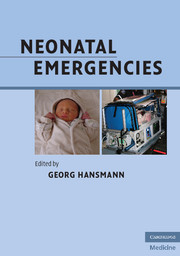Book contents
- Frontmatter
- Contents
- List of contributors
- Foreword (1)
- Foreword (2)
- Preface
- Acknowledgments
- Section 1 Organization of neonatal transport
- Section 2 Basics in cardiopulmonary resuscitation of newborn infants
- Basic equipment setup for initial neonatal care and resuscitation
- Drugs for neonatal emergencies
- Postnatal cardiopulmonary adaptation
- ABC Techniques and Procedures
- Sunctioning
- Stimulation, oxygen supplementation, bag-and-mask ventilation (M-PPV), pharyngeal/bi-nasal CPAP, and pharyngeal positive pressure ventilation
- Endotracheal intubation and gastric tube placement
- Laryngeal mask airway (LMA)
- Chest compressions
- Peripheral venous access
- Umbilical vein/artery catheterization (UVC, UAC)
- Central venous access (internal jugular vein)
- Intraosseous access
- Cord clamping
- Management of high-risk infants in the delivery room
- Monitoring in the delivery room and during neonatal transport
- Hygiene in the delivery room and during neonatal transport (infection control)
- When to call a pediatrician to the delivery room
- Checklist for the postnatal treatment of newborn infants
- Assigning individual duties in the delivery room
- Clinical assessment of the newborn infant
- Cardiopulmonary resuscitation of newborn infants at birth
- Volume therapy and sodium bicarbonate supplementation in preterm and term newborn infants
- Absolute and relative indications for neonatal transport and NICU admission
- Communication with mother and father
- Coordinating neonatal transport and patient sign-out to the NICU team
- Documentation and feedback after neonatal emergency transport
- Ethics in neonatal intensive care
- Perinatal images of preterm and term infants
- Mechanical ventilation of the neonate
- Questions for review (basics)
- References (Section 2)
- Section 3 Classic and rare scenarios in the neonatal period
- Section 4 Transport
- Section 5 Appendix
- Index
- Plate section
Postnatal cardiopulmonary adaptation
from Section 2 - Basics in cardiopulmonary resuscitation of newborn infants
Published online by Cambridge University Press: 05 March 2012
- Frontmatter
- Contents
- List of contributors
- Foreword (1)
- Foreword (2)
- Preface
- Acknowledgments
- Section 1 Organization of neonatal transport
- Section 2 Basics in cardiopulmonary resuscitation of newborn infants
- Basic equipment setup for initial neonatal care and resuscitation
- Drugs for neonatal emergencies
- Postnatal cardiopulmonary adaptation
- ABC Techniques and Procedures
- Sunctioning
- Stimulation, oxygen supplementation, bag-and-mask ventilation (M-PPV), pharyngeal/bi-nasal CPAP, and pharyngeal positive pressure ventilation
- Endotracheal intubation and gastric tube placement
- Laryngeal mask airway (LMA)
- Chest compressions
- Peripheral venous access
- Umbilical vein/artery catheterization (UVC, UAC)
- Central venous access (internal jugular vein)
- Intraosseous access
- Cord clamping
- Management of high-risk infants in the delivery room
- Monitoring in the delivery room and during neonatal transport
- Hygiene in the delivery room and during neonatal transport (infection control)
- When to call a pediatrician to the delivery room
- Checklist for the postnatal treatment of newborn infants
- Assigning individual duties in the delivery room
- Clinical assessment of the newborn infant
- Cardiopulmonary resuscitation of newborn infants at birth
- Volume therapy and sodium bicarbonate supplementation in preterm and term newborn infants
- Absolute and relative indications for neonatal transport and NICU admission
- Communication with mother and father
- Coordinating neonatal transport and patient sign-out to the NICU team
- Documentation and feedback after neonatal emergency transport
- Ethics in neonatal intensive care
- Perinatal images of preterm and term infants
- Mechanical ventilation of the neonate
- Questions for review (basics)
- References (Section 2)
- Section 3 Classic and rare scenarios in the neonatal period
- Section 4 Transport
- Section 5 Appendix
- Index
- Plate section
Summary
An extensive description of perinatal physiological changes is beyond the scope of this handbook. However, for a better understanding, essential key points are listed below.
The fetal alveoli are filled with fluid, the pulmonary vessels are constricted and the pulmonary vascular resistance (PVR) is high. With the first breath, the alveoli are filled with air, leading to establishment of functional residual capacity (FRC), adequate gas exchange and a rapid fall in PVR. During spontaneous breathing, inspiratory airway pressure can initially reach values up to –80 cmH2O (where 1 cmH2O roughly equates to 1 mbar). Under mechanical ventilation, FRC is largely determined by the positive end-expiratory pressure (PEEP) rather than the peak inspiratory pressure (PIP)
Surfactant improves alveolar stability and lung compliance by decreasing surface tension within each alveolus. Surfactant is produced by alveolar type II cells, which are evident in the lung by approximately 24 weeks of gestation. In addition to adequate surfactant production and function, fluid remaining within the alveoli must be cleared by transepithelial transport. Endogenous surfactant production is – in the absence of risk factors – sufficient at the beginning of 35 weeks' gestation. Besides prematurity, lack of functional surfactant is frequently caused by excessive amniotic fluid remaining in the alveoli, e.g., after C-sections, when lungs are not compressed in the small pelvis prior to the first breath and alveolar fluid clearance is delayed
The main stimulus that drives breathing in babies born at 40 weeks' gestation is the PaCO2. The PaO2 response is relatively minor. Oxygen delivery to tissues is initially impaired by high hematocrit levels and the leftward shift of the oxygen – hemoglobin dissociation curve (due to high amounts of fetal hemoglobin, prematurity, hypothermia, alkalosis, hypocapnia, and a decrease of 2,3-diphosphoglycerate)
[…]
- Type
- Chapter
- Information
- Neonatal Emergencies , pp. 63 - 66Publisher: Cambridge University PressPrint publication year: 2009



